Standard: K.RF.2 – Demonstrate understanding of spoken words, syllables, and sounds (phonemes).
Grade level: Kindergarten
Subject: English Language Arts
Domain: Reading: Foundational Skills
Teacher Overview
This standard focuses on developing phonemic awareness, which is the ability to hear, identify, and manipulate individual sounds in spoken words. This foundational skill is crucial for early reading development and sets the stage for future literacy skills. Students should be familiar with basic print concepts, such as recognizing letters and understanding that words are made up of letters.
After mastering this standard, students will be able to decode simple words, improve their spelling, and begin reading fluently.
Common Misconception 1
Some students may think that syllables and sounds are the same. This is incorrect because syllables are units of sound that can contain multiple phonemes.
Intervention 1
To address this misconception, use visual aids and hands-on activities. For example, use blocks to represent syllables and smaller beads for individual sounds within those syllables.
Common Misconception 2
Another common misconception is that the first sound in a word is always the same as the first letter. This is not always true, as in words like ‘knight’ or ‘phone’.
Intervention 2
Provide practice with words where the first sound and the first letter are different. Use picture cards to help students visualize the sounds.
Prerequisite Knowledge
Students should be familiar with basic concepts of print, such as recognizing letters and understanding that words are made up of letters.
Subsequent Knowledge
After mastering this standard, students will be able to decode simple words, improve their spelling, and begin reading fluently.
Instructional Activities
- Clap hands to count syllables in words.
- Use picture cards to identify the first sound in a word.
- Play a game where students blend sounds to make a word.
- Segment words into individual sounds using manipulatives.




